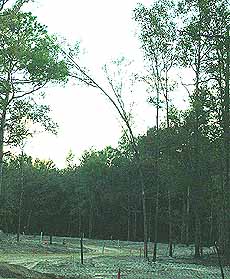Home > Tree structure basics > Structural defects > Trunk bends or leans > More on bends and leans
More on bends and leans
 Trees
that grow and develop in the forest form mostly normal wood. They develop very
little reaction wood because they do not have to. They do not need the reaction
wood to hold them up because have the surrounding trees to help support them
(right photo).
Trees
that grow and develop in the forest form mostly normal wood. They develop very
little reaction wood because they do not have to. They do not need the reaction
wood to hold them up because have the surrounding trees to help support them
(right photo).
Once surrounding trees are removed, those that are left often bend over because they do not have the strength to hold themselves up (left photo). This is due to the lack of reaction wood. Trees that grow close together in the forest often have very few branches on their lower trunk. Lack of lower branches results in a thin trunk unable to support the canopy without surrounding trees.
As a guideline, trees to be saved should have some live healthy branches with a decent amount of foliage on them located in the bottom half of the trunk. (photos by Dr. Jason Grabosky, Rutgers University)


